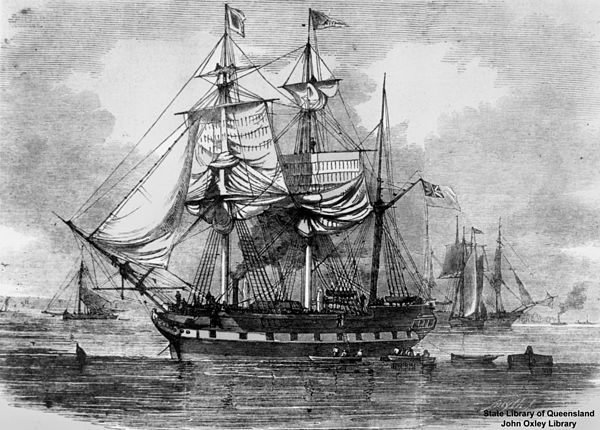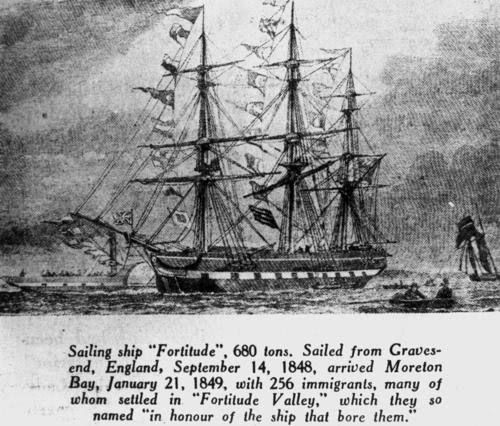Dr Lang and the immigrant ships
Part 1: 170 years ago: 1849 – 2019
Today we start a series about the early days of free settlement in Moreton Bay. On 10 February 1842 Governor Sir George Gipps declared Moreton Bay to be a free settlement and no longer a convict colony.
We’ll look at immigration to Moreton Bay in the late 1840s and the story of the Rev Dunmore Lang and his three immigrant ships, the ss Fortitude, Chaseley and Lima and the immigrants who sailed on them – their arrival and life in the new colony.
It is a story of colonisation, pioneering adventures, hardships, endurance and determination. It is also a tale of disappointments, broken promises, shattered dreams and political ambition. However, above all it is a story of the strength of human endurance and the power of true beliefs; of true fortitude; of coping with the unexpected and not compromising personal beliefs. A story of contrasts and conflicts between convictism and transportation, between separation and anti-separation.
It is the fascinating and inspiring story of the life and times of the immigrants of the Fortitude, Chaseley and Lima who sailed into Moreton Bay in 1849.
Part 2 : An overview of Moreton Bay from penal colony to free settlement 1824-1842.
The Moreton Bay Penal Settlement for hardened criminals and re-offenders was first established on 12 September 1824 in Redcliffe, under Captain Henry Miller. However, the location of the settlement which then housed 30 convicts was soon found to be quite unsatisfactory: it was infested with malarial mosquitoes, the land was unsuitable for growing crops and the water was of poor quality. The colony was relocated to a site on the northern banks of the Brisbane River chosen by Captain Miller. It was on a triangle of land bounded on two sides by the river and what is now known as Miller Park (see map).
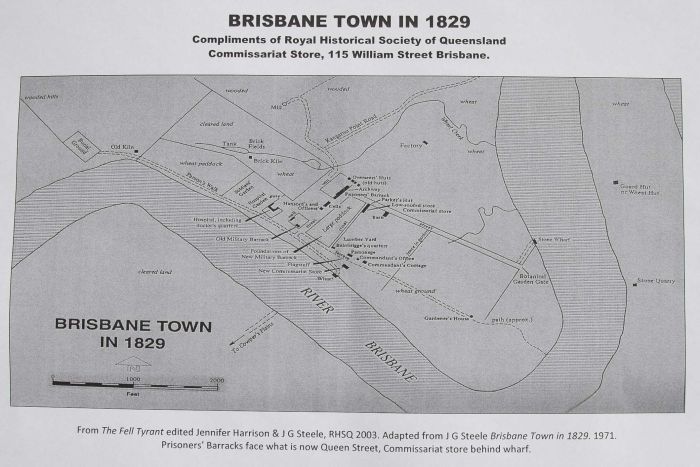
 From 1826 to 1829 the penal colony was run by Captain Patrick Logan who was regarded as a tyrant, between 200 and 1000 convicts lived under his harsh rule.
From 1826 to 1829 the penal colony was run by Captain Patrick Logan who was regarded as a tyrant, between 200 and 1000 convicts lived under his harsh rule.
Stories of tyranny, violence and death from disease helped to fuel agitation in the 1830s to end the convict transportation system and led to a decline in convict numbers.
By 1839 there were only 107 convicts and the penal colony was eventually closed in 1842. The Commissariat Stores and the Windmill are the only surviving stone buildings of the convict era.
On 10 February 1842 Moreton Bay officially ceased to be a penal colony when it was declared a free settlement by Governor Sir George Gipps. Brisbane Town was named its centre and the area was opened up to free settlers.
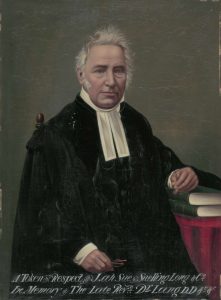
The name John Dunmore Lang is synonymous with the issue of early immigration and free settlement in Australia and particularly in Moreton Bay. He was born in Scotland on 25 August 1799, and was ordained a minister in 1822. After his brother George, who had taken up a land grant in NSW, told him about low levels of morality in the colony he decided to set up Presbyterianism in the colony. He arrived in Sydney in May 1823 and soon founded a congregation, and on 1 July 1824 the foundation stone was laid for his Scots Church.
Lang realised that the new colony could not function without population and he became passionate about encouraging people of good Protestant stock and strong spirit to emigrate.

This detailed pencil sketch, attributed to Henry Boucher Bowerman, depicts Moreton Bay (Brisbane) penal settlement from present-day Kangaroo Point. The panoramic landscape view takes in the Brisbane River in the foreground and existing government buildings necessary to a convict settlement, spread across the land behind. The buildings, some of stone and others slab huts, are interspersed with fields, farm buildings, vegetable gardens and narrow dirt roads. List of buildings and features (left to right) Commandant's house (in a compound), flagpole, engineer's cottage, subaltern's house, soldiers' barracks and two kitchens, guardhouse, lumberyard (in a compound), cells, married soldiers' quarters, convicts' barracks with overseer's hut, windmill and female factory. Also included are a piggery, barn, corn crib and commissariat store.
He returned to England in 1824 and obtained funds for an advance of 1/3 of the estimated church costs from Earl Bathurst, the Secretary of State for the Colonies, as well as an annual salary of £300 for himself. He also obtained approval to use £1,500 of the advance payment to bring a group of workmen and their families to Sydney. In 1831 he returned to Sydney with 140 emigrants, mostly Scottish mechanics and their families. That was the beginning of his long and often tumultuous involvement with immigration. The Scots Church was opened in 1826 and The Rev. John Dunmore Lang was its Minister until his death fifty years later.
Free settlement was established in Queensland on 20 March 1838 when a group of German missionaries inspired by Dr Lang arrived in Moreton Bay in the schooner Isabella, having come to Sydney in the Minerva. Their aim was to minister to the local aborigines. They established a settlement in what is now Nundah which for many years was known as German Station.
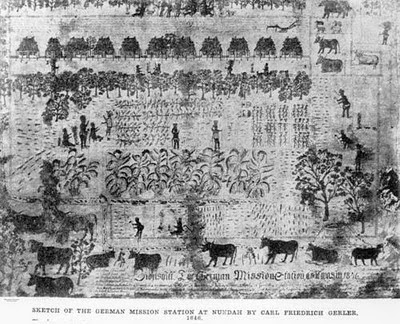
While they got on well with the aborigines, they did not manage to convert them to Christianity. With their influence waning, the ministers left and the mission closed in 1845; the laymen established farms, many buying their own land when the Government surveyed the land into blocks in 1848. That was the beginning of significant German immigration and settlement in Queensland.


Other free settlers, known as squatters, had settled in Moreton Bay since 1840. They came via New England and settled on the Darling Downs. The first was Patrick Leslie and many others soon followed him.
One of the major effects of free settlement was the increasing shortage of labour. Squatters had been relying on cheap convict labour and the better class ‘ticket-of-leave’ men and were happy with their work on the sheep and cattle stations. When this labour was no longer available, problems arose and for a time there was pressure to re-instate the convict system.
It was time for Dr Lang to bring out three more immigrant ships (to be continued).
Part 3: The Labour debate and the Cooksland emigration scheme
The labour issue dominated and slowed the progress of the newly declared free settlement from 1842-1852. The pastoralists desperately needed manual workers, shepherds, tradesmen and domestics and were unhappy that cheap convict labour was no longer available.
This was an issue close to the heart of Dr Lang and he fought fiercely against the proposal to revive the convict system. In 1845 he went up to Moreton Bay to appraise the situation for himself and study colonial life. By then he had started to become well-known for his strong views and fierce attacks on what he saw to be the loose morality and licentious way of life in the colony, especially sexual activity outside marriage. He freely voiced his opinions and feared no one. He was energetic, decisive and strong-willed, but solid in his beliefs despite making many enemies.
Bitter disagreements developed between the squatters and Lang. The battle lines were drawn with Patrick Leslie, the first squatter, representing the ‘pro-convict labour’ movement and Dr Lang the ‘free labour’ movement. Disputes became fiery and acrimonious.
Lang’s dream was for the land to be settled by emigrants who were free, honest and respectable, preferably Protestant and preferably Scottish. He wanted to establish a new middle class with clergymen, doctors, teachers and highly skilled artisans who would form respectable agricultural communities and lay the foundations of a great State. They would grow cotton, sugar and other products with cotton ultimately becoming the main crop and Moreton Bay the major supplier to the British textile industry, He proposed setting up a Moreton Bay Cotton Company and established a Cooksland Colonisation Company.
A year after his visit to Moreton Bay he went to England to pursue his dreams for the colony. He tried to get Colonial authorities interested in his plans, but was unsuccessful. Instead, his endeavours led to the authorities taking action themselves to meet the labour demand and they sent out the first Government-sponsored ship, the Artemisia, a new ship of 558 tons which made her maiden voyage bringing immigrants to Moreton Bay. She left Plymouth with 210 migrants on 15 August 1848 and arrived off Moreton Bay on 13 December.
Angered, but undeterred by the lack of Government support Lang decided to send 600 emigrants mostly Presbyterian Scots out to Moreton Bay himself. He chartered three ships, the ss Fortitude, Chaseley and Lima. He personally selected those who were intelligent, experienced and possessed the qualities of courage, endurance and self-reliance. After discussions with Mr. Hawes, the Under-Secretary for the Colonies, he believed that he had received a verbal assurance of cooperation for his proposal that any emigrants sent out by him would receive an area of land depending on what they paid for their passage. This, unfortunately, turned out to be a mistaken belief. He personally financed the venture at huge personal loss to him (£1,300 in case of the Fortitude alone). He issued the emigrants with land orders (at the rate of £16 for every £20 they paid him) which they were to present to the local authorities on arrival and then receive their land grant. However, he actually had no official authority to issue any such land orders.
On 14 September 1848 the barque Fortitude, the first of the three ships, left Gravesend with about 260 emigrants on its voyage to an unknown destiny in Moreton Bay, Cooksland. (to be continued)
Part 4: The voyage of the ss Fortitude
The 608-ton ship Fortitude was the first Lang ship to sail for Moreton Bay. It carried over 256 devout evangelical settlers collected by Rev John Dunmore Lang from all over England. Their occupations listed were agriculturalists, builder, bricklayer, plasterer, carpenter, joiner, engineer, blacksmith, saddler, harness maker, draper, tailor, shoemaker, analytical chemist, watchmaker, bookseller, schoolteacher and preachers.
On 14 September 1848 Captain John Christmas sailed the barque Fortitude out of Gravesend in Kent, England and headed to Moreton Bay in what Dr Lang described as Cooksland, now Queensland. In the beginning a lot of the passengers suffered from seasickness.
The trip took four months and the ship sailed non-stop southwest over to South America and caught the trade winds across to Australia passing south of South Africa and through Bass Strait, south of Australia and then heading north to Brisbane Town. They sighted many ships during the journey but only one ship stopped which was going to England and hurried letters were exchanged. At another part of the voyage a whaling boat also sent its longboat across for news.
They were becalmed for long periods and in the tropics the heat was oppressive and sapped their strength. Food was not a problem and they caught fish and birds and even sharks to supplement the diet. As they got down towards the Cape of Good Hope the weather was more bearable although they were sometimes plagued by unfavourable winds that even sent them backwards.
Rev. Charles Steward, a Baptist Minister, was engaged as the Minister for the Ship to serve Presbyterian and Independent Baptist congregations. He conducted regular services and the Captain read prayers on Sundays. The schoolteacher Samuel Welsby conducted regular lessons and those with musical instruments often entertained, so shipboard life was fairly busy.
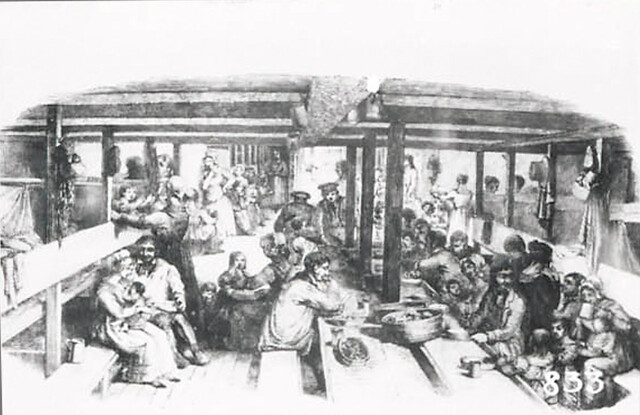
The migrants ate and slept below deck in cramped quarters which contributed to eight deaths of three adults and five children mostly caused by Typhus and fever, and during the voyage four births occurred. Doctor Challinor was the ship’s doctor and attended to the sick and the dying on the ship.
Little did they know what surprises awaited them on their arrival in Moreton Bay (to be continued).
(adapted from The Voyage of the ss Fortitude by Barry Alexander).
Part 5: Arrival of the ss Fortitude in Moreton Bay
After their long sea voyage the ss Fortitude finally sailed into Moreton Bay on 20 January 1849 with 256 immigrants. However, their arrival was not exactly what they had envisaged. They did not receive the welcome and support they expected and were denied the land grants promised by Dr Lang which had been the major incentive for them to leave their homeland.
Lang had assumed that the colonial authorities in London would have changed their attitude and accepted his proposal. He believed that local authorities would have been prepared for the arrival of the Fortitude from communication via the Artemisia which had arrived a month before them. Unfortunately his assumptions turned out to be completely wrong.
The colonial government resented the fact that Lang had not been in direct contact with them and had made no proper arrangements for the arrival of the immigrants. He had only sent a few letters to the Moreton Bay Courier in which he introduced some of the more prominent passengers such as the Baptist pastor Charles Stewart and surveyor William Pettigrew and asked for local help to assist the immigrants settle in. Consequently the anticipated friendly reception turned into a very hostile reception and the new arrivals were treated like intruders. John Richardson, the agent Lang had appointed to look after the newcomers, refused to help, claiming he had not been informed.
The ship was put under government control and it was up to the Police Magistrate, Captain Wickham, the local representative of the Government in Sydney, to deal with the situation. He expressed his frustrations in a private letter to Francis Merewether, the immigration agent (see below). The government denied any knowledge of the land grants and ordered Captain Wickham not to give the immigrants any assistance or allow them to settle, even temporarily, on Crown land.
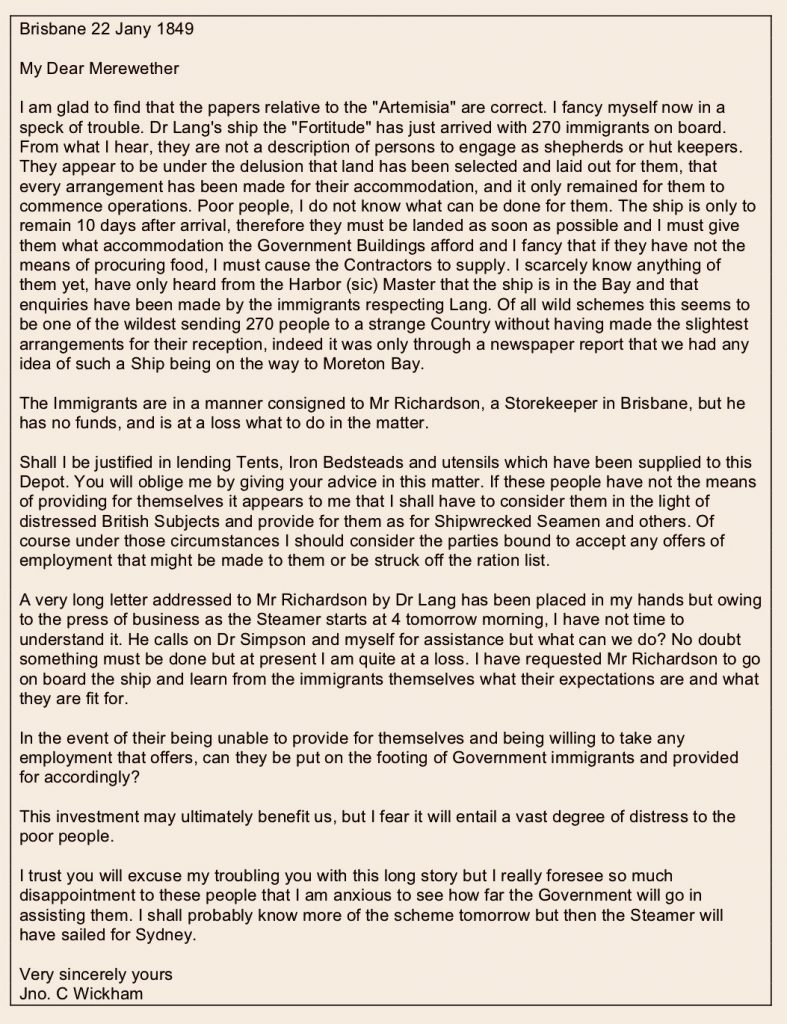
After hearing that there had been cases of typhus during the voyage, Captain Wickham placed the ship in quarantine on Moreton Island for two weeks. As the Brisbane River at the time was only a shallow, mangrove-fringed stream with a depth of 12feet at the bar at low tide a smaller vessel was needed to take them to the town. They chartered the schooner Susan at their own expense to ferry them and their luggage to the town and were dropped off at a wharf opposite Kangaroo Point.
In line with Government orders, no accommodation was provided for them in town, but Captain Wickham allowed them to set up a temporary camp out of sight beyond the ridge in Yorks Hollow, which is now Fortitude Valley. They set up camp and cared for themselves until they found employment and moved….
So how did the immigrants feel about their situation?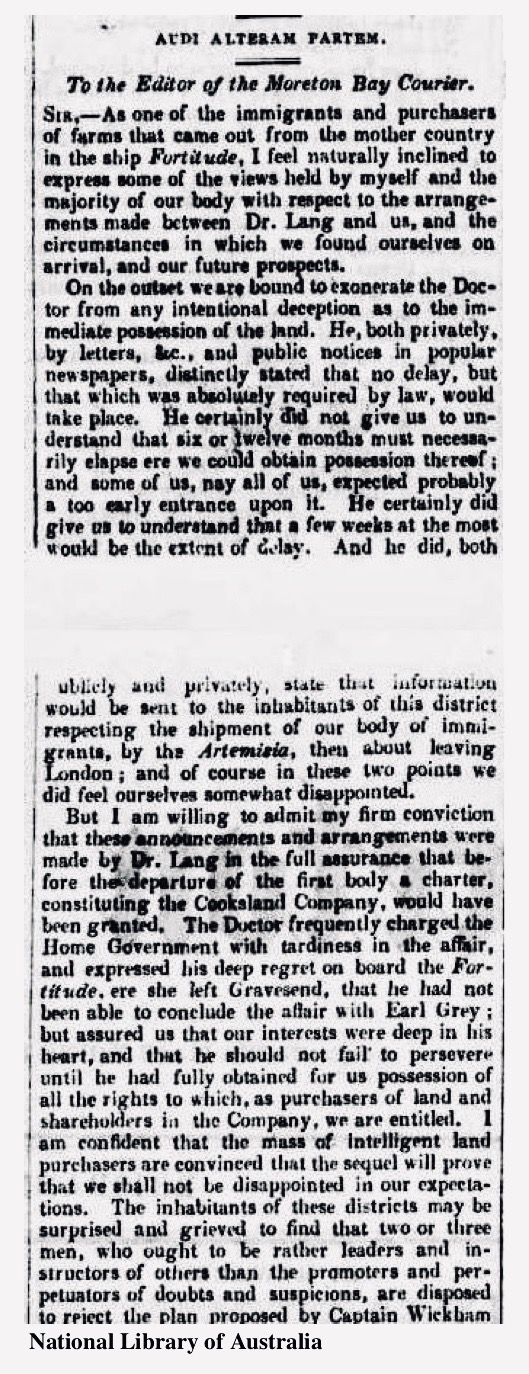
Although they were disappointed that they did not get the promised land they still supported Lang. They believed in his altruistic aims to promote settlement in the new country and believed he was sincere and genuine in his desire to do what is right. There is no record of them complaining as they faced the challenges head-on and adapted to the harsh conditions. They were united by their common plight and strengthened in their resolve to be an important part of laying the foundations of a great State. as they summoned their strong spirit of optimism, independence and perseverance and set out to create their own opportunities. Many found employment as station hands; others opened their own businesses as painters, dressmakers, tailors and some, led by Mr. Pettigrew, went out to look at the land.
They made fortitude their motto and named the area FORTITUDE VALLEY after their ship.
Part 6: HMS Fortitude – formerly HMS Cumberland

Dr Lang’s ship Fortitude was the former HMS Cumberland, a 74 gun 3rd rate ship of the Royal Navy. She was launched on 19 August 1807. During the Napoleonic wars she brought King William I of the Netherlands from London to the Netherlands. She was converted for use as a prison ship in 1830 and was used as a convict ship until 1833. She was then renamed HMS Fortitude. HMS Fortitude was the first of three immigrant ships chartered by Dr John Dunmore Lang to bring immigrants out from England to Moreton Bay in 1849. She was eventually sold for scrap in 1870. The photo shows HMS Fortitude as she would have looked in Moreton Bay in 1849. (research: Darcy Maddock).

Part 7: The Voyage of the ss Chaseley
170 YEARS AGO TODAY ON 1 MAY 1849 the second of Dr Lang’s immigrant ships, the ss Chaseley arrived in Moreton Bay after a long and arduous journey of 120 days.
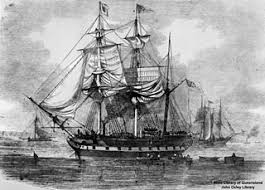 The 515-ton ss Chaseley was built in 1845. She was a three-masted vessel similar to the Fortitude. She had left London on 27 December 1848 with 214 immigrants, 62 adult males, 50 adult females, and 86 children under 14. There were a few cabin class passengers but the immigrants were crammed into steerage. However, Captain Aldrich had given them access to the upper deck and poop deck.
The 515-ton ss Chaseley was built in 1845. She was a three-masted vessel similar to the Fortitude. She had left London on 27 December 1848 with 214 immigrants, 62 adult males, 50 adult females, and 86 children under 14. There were a few cabin class passengers but the immigrants were crammed into steerage. However, Captain Aldrich had given them access to the upper deck and poop deck.
It was a cold winter’s day with storms of snow and sleet. Storms increased in the Bay of Biscay and washed away all the deck poultry and sheep except one. Therefore there was no fresh meat during the voyage and they had to exist on salted beef, pork and butter. Rats were in plague proportions and would even take food from the tables.
Shipboard life soon became a routine of schooling, worshipping, fishing, cooking, washing, sewing and musical evenings. In the early weeks many were seasick and they had to endure terrible weather ranging from high seas, rain, hail and strong winds. Dr Hobbs did what he could to care for them. They saw many other ships and sometimes stopped and rowed between vessels to exchange greetings and information and pass over letters to families back home. There were births, deaths and burials at sea throughout the voyage. Despite the tough conditions many lasting friendships were made.
After a few weeks the weather improved as they got further south past the islands of Madeira and the Canaries. From the extremes of cold they now had to suffer the heat and humidity of the tropical latitudes. On top of that, a current that carried them across the Atlantic to the East Coast of South America, much to the Captain’s disbelief, lengthened their journey. They had to sail back across the Atlantic from South America to go around the bottom of South Africa’s Cape of Good Hope, then cross the Indian Ocean and into the Great Australian Bight. They then rounded the southeast corner of Australia near Melbourne before heading u the east coast.
The Chaseley finally arrived in Moreton Bay on 1 May 1849. The next day after completing Customs and Health checks they, like the Fortitude passengers before them, they made many trips in small river steamers at their own expense, to get themselves and their luggage upstream along a mangrove filled winding river to the settlement of Brisbane.
Night was closing in when they stepped ashore and it was raining heavily. To add to their misery, Captain Wickham told them that he was instructed from Sydney not to render any assistance to Dr Lang’s immigrants. In this regard nothing had changed since the arrival of the Fortitude four months earlier. However, Wickham took pity on the new arrivals and offered them the old convict barracks for a few days until the next shipload of convicts arrived. (to be continued).
Part 8: The voyage of the ss Lima
The third and last of Dr Lang’s immigrant ships was the much smaller 349 ton barque Lima which was only three years old. Under the command of Captain Adam Yule she left Gravesend on 27 June 1849 with 110 personally selected immigrants keen to seek a new life in Cooksland. Many paid for their own passage and brought agricultural labourers with them in anticipation of receiving their promised land grants.
Their voyage was much the same as that of the previous two ships and they experienced similar problems of seasickness, cold, heat, illness due to lack of fresh food and lack of privacy in cramped conditions. They were well cared for by surgeon superintendent Dr Frederick Wilkinson and the Rev. Samuel Baker a fellow passenger who looked after their spiritual welfare.
On 17 October they arrived and dropped anchor in Watson’s Bay, Sydney where 26 passengers disembarked to settle in New South Wales. Anchored next to them was
the convict ship Mount Stuart Elphinstone with 240 convicts, it had been refused entry to Sydney by the New South Wales authorities and told to take its convicts to Moreton Bay where she arrived two days ahead of the Lima. This angered the new migrants, as they believed that transportation had ended and many of them would later become involved in the anti-transportation movement gaining momentum.
The Lima set sail again two days later and headed north to Moreton Bay where they arrived on 3 November after a voyage of 130 days. On arrival they, just like those on the Fortitude and Chaseley before them, had to organise and pay for their own transport from the Bay to the settlement. They chartered the small steamship Tamar to take them up the winding river and passed a vote of thanks to their captain and the Rev Samuel Baker.
They arrived in the Brisbane township to a reception which was markedly different from that received by their predecessors on the Fortitude and Chaseley. Not only had their arrival been expected and planned for, but they were also given a warm and friendly reception and offered accommodation in bark huts which had been specially built for them! On top of that, their land grant documents were accepted and they received the land they had been promised! (Trove/Lang’s ships 150-year reunion book).
So far we’ve been unable to locate a photo of the Lima – hopefully someone will have one
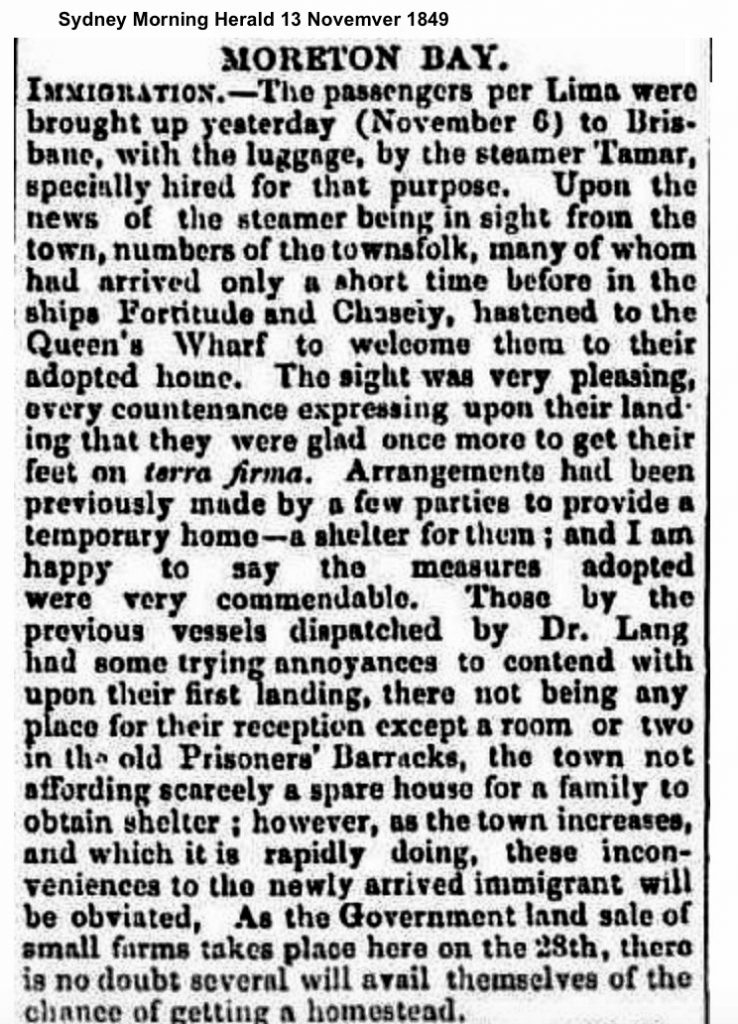
This letter written by Dr John Dunmore Lang to the people of Moreton Bay regarding the third of his immigrant ships, the ss Lima was published in the Moreton Bay Courier on 10 November, 7 days after the arrival of the Lima. It contains a clear statement of the objectives of his immigration program and his plans for establishing a successful cotton industry in the area.
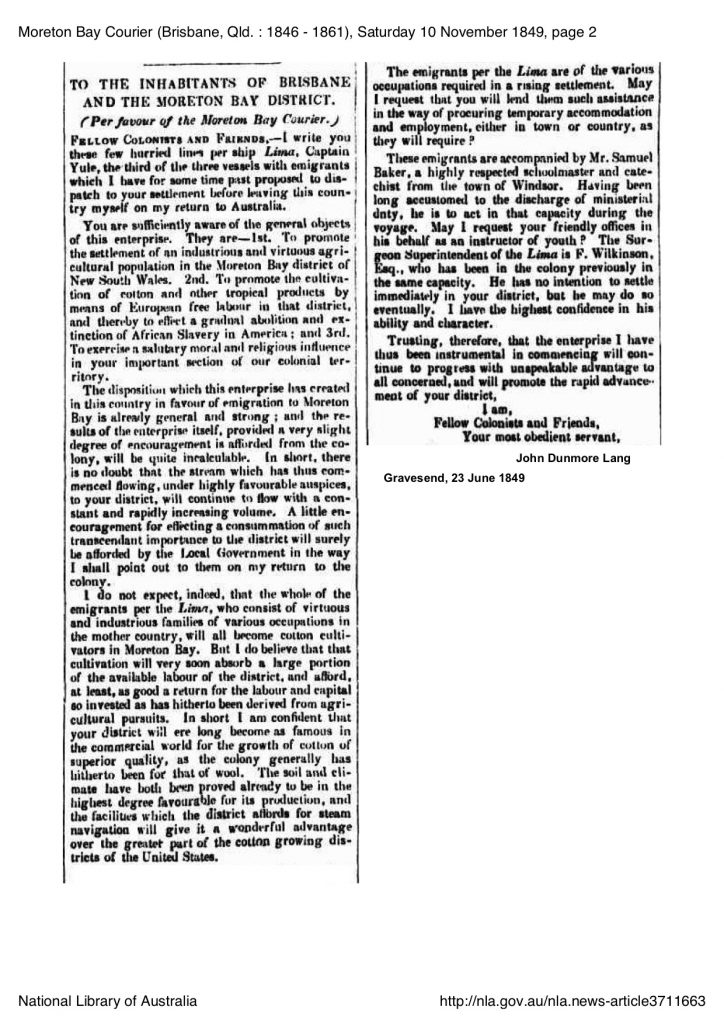
Dr Lang and the immigrant ships – Part 10
The Pioneers Reunion Picnic
The Pioneers Picnic, first held on the 1st of May 1899, was the jubilee of the landing of Doctor John Dunmore Lang’s pioneers in Brisbane. About 600 hundred pioneers arrived in Brisbane in 1849 on the ships ‘Fortitude’, ‘Chaseley’ and ‘Lima’. The picnic was attended by over three hundred, including immigrants and their descendants.
This year is the 120th anniversary of the Pioneers Picnic.
Today we mark the 170th anniversary of the arrival of the three ships in Moreton Bay.

